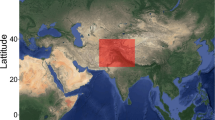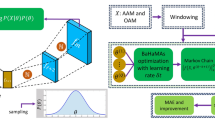Abstract
This paper contributes with an alternative to the multivariate Analogue Method (AM) version, using a preprocessing stage carried out by an Autoencoder (AE). The proposed method (MvAE-AM) is applied to reconstruct France’s 2003, Balkans’ 2007 and Russia 2010 mega heat waves. Using divers such as geopotential height of the 500hPA (Z500), mean sea level pressure (MSL), soil moisture (SM), and potential evaporation (PEva), the AE extracts the most relevant information into a smaller univariate latent space. Then, the classic univariate AM is applied to search for similar situations in the past over the latent space, with a minimum distance to the heat wave under evaluation. We have compared the proposed method’s performance with that of a classical multivariate AM (MvAM), showing that the MvAE-AM approach outperforms the MvAM in terms of accuracy (\(+1.1257\)C), while reducing the problem’s dimensionality.
Access this chapter
Tax calculation will be finalised at checkout
Purchases are for personal use only
Similar content being viewed by others
References
Salcedo-Sanz, S., et al.: Analysis, characterization, prediction, and attribution of extreme atmospheric events with machine learning and deep learning techniques: a review. Theoret. Appl. Climatol. 155, 1–44 (2023)
Barriopedro, D., Garcia-Herrera, R.A., Ordóñez, C., Miralles, D.G., Salcedo-Sanz, S.: Heat waves: Physical understanding and scientific challenges. Rev. Geophys. 61 (2023)
Rousi, E., Kornhuber, K., Beobide-Arsuaga, G., Luo, F., Coumou, D.: Accelerated western European heatwave trends linked to more-persistent double jets over Eurasia. Nat. Commun. 13 (2022)
Papari, J.R., Perkins-Kirkpatrick, S.E., Sharples, J.J.: Intensifying Australian heatwave trends and their sensitivity to observational data. Earth’s Future 9 (2020)
White, R.H., et al.: The unprecedented pacific northwest heatwave of June 2021. Nat. Commun. 14 (2023)
He, G.-X., et al.: Assessing the impact of atmospheric heatwaves on intertidal clams. Sci. Total Environ., 156744 (2022)
Siboni, N., et al.: Increased abundance of potentially pathogenic vibrio and a marine heatwave co-occur with a pacific oyster summer mortality event. Aquaculture (2024)
Materia, S., et al.: Summer temperature response to extreme soil water conditions in the Mediterranean transitional climate regime. Clim. Dyn. 58, 1943–1963 (2021)
López-Bueno, J.A., et al.: Evolution of the threshold temperature definition of a heat wave vs. evolution of the minimum mortality temperature: a case study in Spain during the 1983-2018 period. Environ. Sci. Eur. 33, 1–10 (2021)
Torralba, V., et al.: Nighttime heat waves in the euro-Mediterranean region: definition, characterisation, and seasonal prediction. Environ. Res. Lett. (2024)
Adnan, M.S.G., Dewan, A., Botje, D., Shahid, S., Hassan, Q.K.: Vulnerability of Australia to heatwaves: a systematic review on influencing factors, impacts, and mitigation options. Environ. Res., 113703 (2022)
Fister, D., Pérez-Aracil, J., Peláez-Rodríguez, C., Ser, J.D., Salcedo-Sanz, S.: Accurate long-term air temperature prediction with a fusion of artificial intelligence and data reduction techniques. ArXiv abs/2209.15424 (2022)
Ren, L., Zhou, T., Zhang, W.: Attribution of the record-breaking heat event over northeast Asia in summer 2018: the role of circulation. Environ. Res. Lett. 15 (2020)
Zorita, E., von Storch, H.: The analog method as a simple statistical downscaling technique: comparison with more complicated methods. J. Clim. 12, 2474–2489 (1999)
Gao, X., Schlosser, C.A., Morgan, E.: Application of the analogue method to modeling heat waves: a case study with power transformers 16 (2017)
Pinaya, W.H.L., Vieira, S., Garcia-Dias, R., Mechelli, A.: Autoencoders. In: Machine Learning, pp. 193–208. Elsevier (2020)
Caillouet, L.P., Vidal, J., Sauquet, E., Graff, B., Soubeyroux, J.M.: Scope climate: a 142-year daily high-resolution ensemble meteorological reconstruction dataset over France. Earth Syst. Sci Data (2019)
Russo, S., Sillmann, J., Fischer, E M.: Top ten European heatwaves since 1950 and their occurrence in the coming decades. Environ. Res. Lett. 10 (2015)
Hersbach, H., et al.: The era5 global reanalysis. Q. J. R. Meteorol. Soc. 146, 1999–2049 (2020)
Demirtaş, M.: The anomalously hot summer of 2021 over the euro-Mediterranean region: underlying atmospheric drivers and heatwaves. Theor. Appl. Climatol. 152, 861–870 (2023)
Jézéquel, A., Yiou, P., Radanovics, S.: Role of circulation in European heatwaves using flow analogues. Clim. Dyn. 50, 1145–1159 (2018)
Salinger, M.J., et al.: The unprecedented coupled ocean-atmosphere summer heatwave in the new Zealand region 2017/18: drivers, mechanisms and impacts. Environ. Res. Lett. 14 (2019)
Zeder, J., Fischer, E.M.: Quantifying the statistical dependence of mid-latitude heatwave intensity and likelihood on prevalent physical drivers and climate change. Adv. Stat. Climatol. Meteorol. Oceanograp. (2023)
di Capua, G., et al.: Drivers behind the summer 2010 wave train leading to Russian heatwave and Pakistan flooding. NPJ Climate Atmospheric Sci. 4, 1–14 (2021)
Lorenz, E.N.: Atmospheric predictability as revealed by naturally occurring analogues. J. Atmos. Sci. 26, 636–646 (1969)
Grotch, S.L., Maccracken, M.C.: The use of general circulation models to predict regional climatic change. J. Clim. 4, 286–303 (1991)
Hulme, M.: Attributing weather extremes to ‘climate change’ a review. Prog. Phys. Geogr. 38(4), 499–511 (2014)
Faranda, D., Vrac, M., Yiou, P., Jézéquel, A., Thao, S.: Changes in future synoptic circulation patterns: consequences for extreme event attribution. Geophys. Res. Lett. 47 (2020)
Acknowledgements
This research has been partially supported by the European Union, through H2020 Project “CLIMATE INTELLIGENCE Extreme events detection, attribution and adaptation design using machine learning (CLINT)”, Ref: 101003876-CLINT. The present study has been partially supported by the “Agencia Estatal de Investigación (España)” (grant ref.: PID2020-115454GB-C21 and PID2020-115454GB-C22 through the projects of the Spanish Ministry of Science and Innovation (MICINN). David Guijo-Rubio has been supported by the “Agencia Estatal de Investigación (España)” MCIU/AEI/10.13039/501100011033 and European Union NextGenerationEU/PRTR (grant ref.: JDC2022-048378-I).
Author information
Authors and Affiliations
Corresponding author
Editor information
Editors and Affiliations
Rights and permissions
Copyright information
© 2024 The Author(s), under exclusive license to Springer Nature Switzerland AG
About this paper
Cite this paper
Marina, C.M., Lorente-Ramos, E., Ayllón-Gavilán, R., Gutiérrez, P.A., Pérez-Aracil, J., Salcedo-Sanz, S. (2024). Multivariate-Autoencoder Flow-Analogue Method for Heat Waves Reconstruction. In: Alonso-Betanzos, A., et al. Advances in Artificial Intelligence. CAEPIA 2024. Lecture Notes in Computer Science(), vol 14640. Springer, Cham. https://doi.org/10.1007/978-3-031-62799-6_23
Download citation
DOI: https://doi.org/10.1007/978-3-031-62799-6_23
Published:
Publisher Name: Springer, Cham
Print ISBN: 978-3-031-62798-9
Online ISBN: 978-3-031-62799-6
eBook Packages: Computer ScienceComputer Science (R0)




